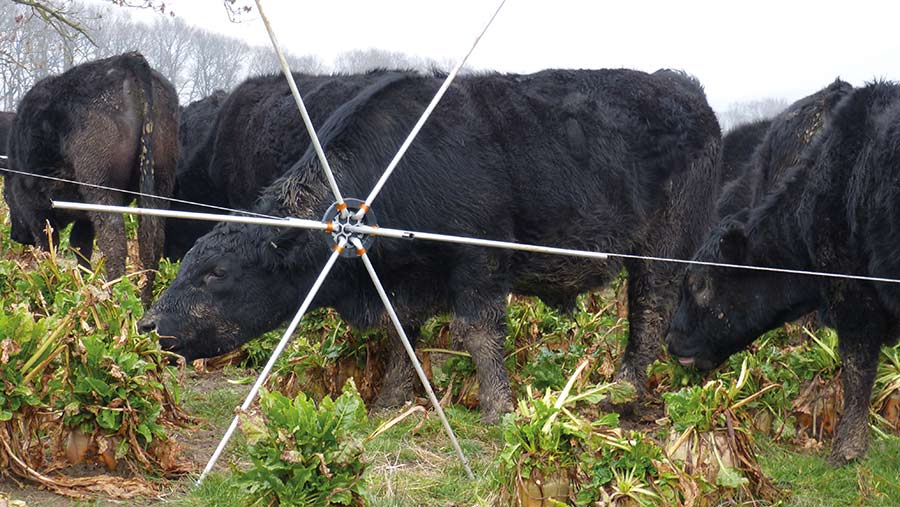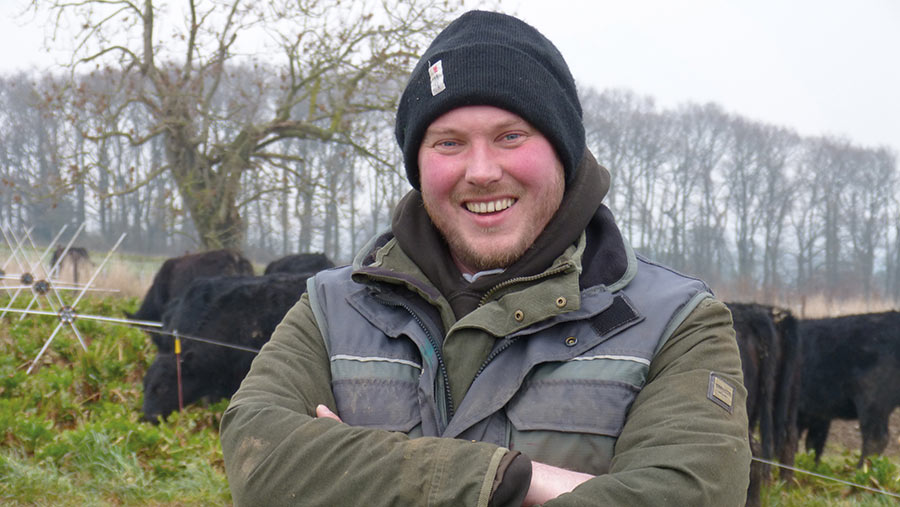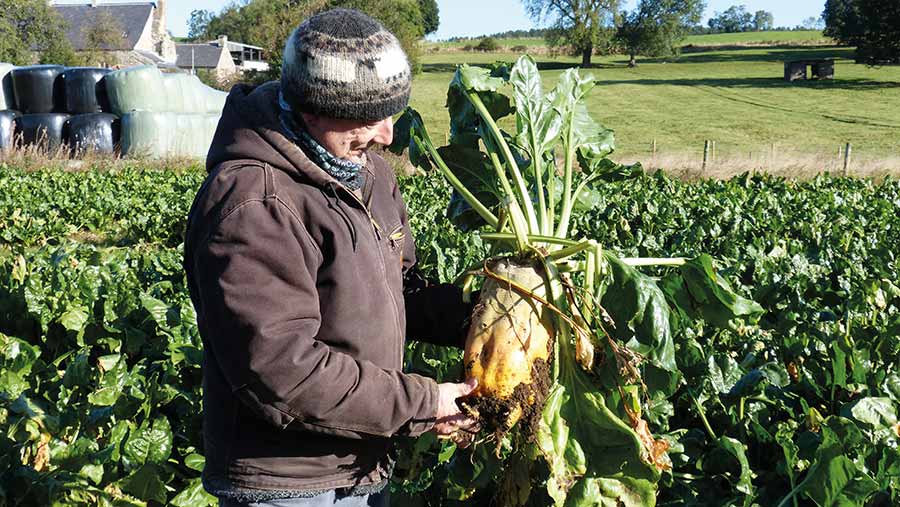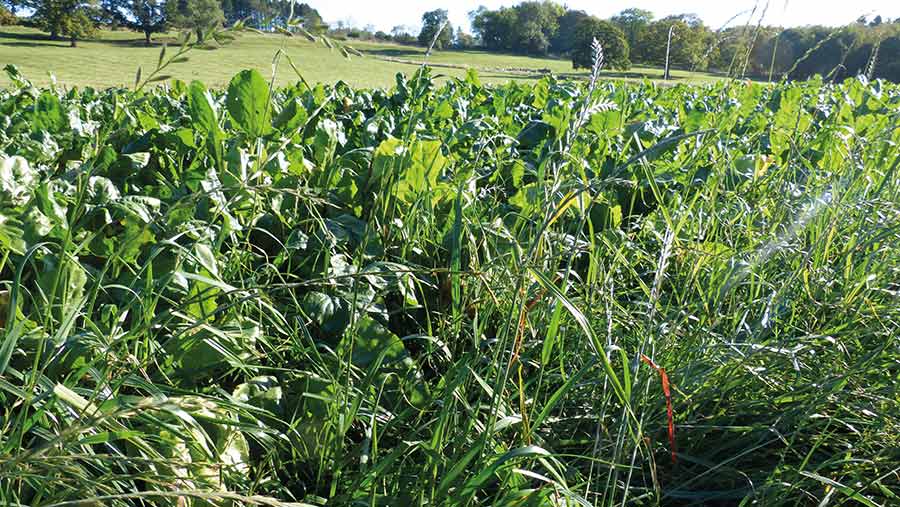Video: Beet and grass mix gives 57p/day winter for grazier

There are many benefits to outwintering cattle and sheep on a diet of forage grass and beet.
We speak to sheep and beef farmer James Drummond in Alnwick and farmer Paul Allison in County Durham about their grazing systems.
See also: How to grow better fodder beet – 5 expert tips
James Drummond
Grazing forage through the winter without the need to start a tractor has cut wintering costs for a Northumberland sheep and beef farm.
The 2021-22 winter is the third year the Drummonds, of Lemmington Hill Head, Alnwick, have grown fodder beet for their cattle.
During the first winter, they put bales along one side of the beet area to provide fibre for healthy rumen function.
The past two winters, however, saw further experimentation, with the fibre coming from grazed grass.
James Drummond, who farms with his father, Tony, stresses that field choice is important but outwintering is worthwhile as it costs only 28p-57p a head a day to take cattle through the winter.
Watch the video of James Drummond demonstrating his cattle system and read the rest of the report below.
Farm facts: Lemmington Hill Head
- 60 cows and 25 heifers, with calving at two years
- 1,500 ewes tupped, including 400 ewe lambs
- Nucleus flock for Innovis – sold 280 tups last year
- 220ha (544 acres) on an Agricultural Holdings Act tenancy
System
The land runs north to south along a slight ridge. The top of the ridge, near the main road, is used for outwintering sheep and cattle, while the lower-lying parts are used for lambing and leader-follower grazing in the summer.
The farm has five sheep wintering blocks. These are grazed for four years with winter crops (fodder beet) followed by six years in herbal leys.
Three cattle wintering blocks are currently run on a six-year cycle comprising a three-year herbal ley, a winter of bale grazing with deferred herbal ley grazing, and two years of beet and grass for outwintering.

James Drummond © MAG/Michael Priestley
Each of the cattle blocks is 8ha (20 acres). For the final two years of the cycle, 4ha (10 acres) of beet and 4ha (10 acres) of grass are rotated around each block.
The rotation is firstly beet and grass, and then the crops are “flipped over”, growing grass and beet at a 50:50 ratio for the cattle, in the same field.
This year, 35 yearlings and 26 weaned calves were outwintered separately on four lanes consisting of 1ha (2.5 acres) of beet and 1ha (2.5 acres) of grass.
The beet variety Geronimo was tried for winter 2021-22. This is drilled late in April to avoid frosts which can lead to bolters, explains Mr Drummond.
The grass half of the field is drilled with winter-hardy Westerwolds, Italian ryegrasses and clovers (red, Egyptian and crimson).
It is silaged twice in the summer to make winter feed for late-gestation ewes.
A beet lifter has been used to transition the cattle to beet in a variety of ways while avoiding acidosis.
One way was to transition young (R1) cattle onto beet at grass in November while still on their mothers.
Now, they are weaned before transition: they are housed for 10-12 days and fed beet and hay, then turned onto the crop once they are eating three to four beet a day.
“The important thing is that rumens are conditioned to eating it, and it takes longer the older the cattle are,” says Mr Drummond.
Benefits
- Less compaction Because no bales are needed, this means less tractor work
- Good for public image Cattle have a nice dry lie in the grass and can be walked down to the bottom end of the field and grazed uphill to the road. This means the public driving along the road see the crop, rather than grazed, brown residual for most of the winter
- Wildlife Having two crops in the field creates a more diverse habitat for wildlife. Clovers are full of insects in the summer and provide cover for birds
- Animal welfare Grass is a lower dry matter (DM) crop than beet, but this means every fence move is further than it would be for a field of 100% beet, to ensure sufficient dry matter is provided. This has the added benefit of giving cattle more area and results in less poaching.
Beet is the more expensive of the two crops to grow. Last year a micronutrient package, a pre-emergent herbicide, an insecticide and a later herbicide were applied.
Crop costs |
||
|
Beet |
Grass |
Intakes and daily costs |
|
Rent £145/ha Seed £190/ha Drilling (contractor, includes fuel) £55/ha Fertiliser £191/ha Sprays £180/ha Total £761/ha Cost/kg dry matter (DM) = 2.5p at 30t DM/ha yield or 4.2p at 18t DM/ha yield |
Rent £145/ha Seed £104/ha Drilling (contractor, includes fuel) £55/ha Total £304/ha Yield amounts to 1.5t grazed and 10.5t baled silage the previous summer for late gestation ewes = 2.5p/kg DM (before summer contractor costs for sheep silage) |
|
Paul Allison
Low Harperley, Wolsingham, County Durham
Weardale farmer Paul Allison experimented this winter with a 50:50 beet and grass crop as a cheap wintering option for ewes and weaned heifers at Low Harperley, where he breeds Salers cattle and runs Lleyn ewes.

Paul Allison © MAG/Michael Priestley
He was worried the ewes were not getting enough protein.
His vet took blood samples for a metabolic profile of the sheep in late January, and the report suggested they were protein-deficient, so Mr Allison allocated ewes additional grass within the field.
Another blood test in mid-February showed the change had not completely fixed the problem, so Mr Allison allowed the ewes to run back to an adjacent grass field to access a cover of 2,750kg dry matter (DM)/ha and boost protein in the diet.
Next year he plans to drill 60-70% of the wintering field as grass, with the rest as beet.
“Ewe intakes started at about 1.2kg DM a day and finished on about 2kg DM,” he said. “I’ve found the key to grazing beet is a long feed face, so sheep have one row of beet a day to minimise trampling.”

© MAG/Michael Priestley
Benefits
- Low cost Stock are outwintered without expensive silage, saving about £15-£20 a bale
- Less waste With no need to move the electric wire past silage bales, daily shifts can be optimised and less leaf is trampled
- Less labour There are no bales to move, unwrap or be attacked by birds in the autumn, saving on mess, hassle and field compaction
- High protein The grass part of the diet is high in protein which balances the high-energy beet. A wet chemistry analysis found the Westerwolds was 26% crude protein. In July the same field produced 17% crude protein silage
Wintering system
- Field size 8ha (20 acres) with 4ha (10 acres) beet and 4ha (10 acres) grass
- Yield The beet half of the field produced 20t DM/ha; the grass half did 10t DM/ha (5t DM/ha as silage)
- Carrying 370 ewes from mid-December to late March and 60 weaned heifers from late January to May
- Species Lactemo beet, a lower-yielding, taller bulb variety, and winter-hardy Westerwolds grass
- Rotation The 8ha (20 acre) block has water troughs and fencing for strip-grazing so is used for wintering continually. The rough plan is to grow beet and grass, then grass and beet, and then swedes, in rotation. As beet is not a brassica, there is no clubroot risk
